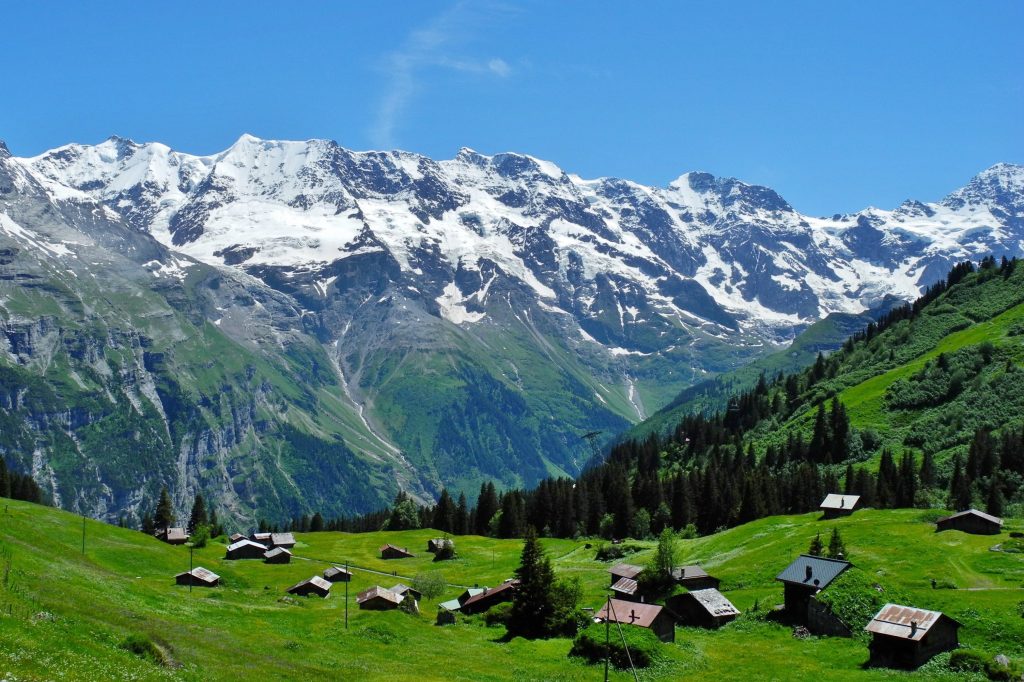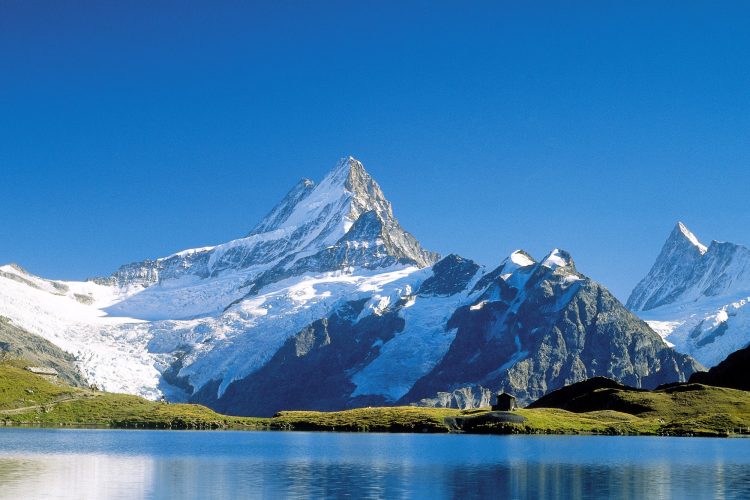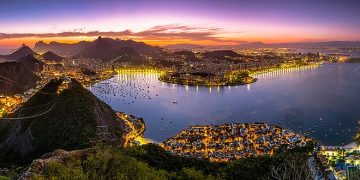The Alps, a majestic mountain range in south-central Europe, are not only a wonder of nature, but also a witness to human history and culture. Spanning northern Italy, southeastern France, Switzerland, Liechtenstein, Austria, southern Germany and Slovenia, it attracts explorers, travelers and scientists with its magnificent mountains, abundant water resources, diverse ecosystems and deep cultural heritage. This paper will deeply discuss the natural features, historical background, cultural characteristics of the Alps and its influence on modern society.
Natural wonders: Masterpieces of nature
1.1 Geographical Overview
The Alps range extends from the subtropical Mediterranean coast near Nice in France to the north to Lake Geneva, and then to the northeast to Vienna on the Danube River, with an arc spread, a total length of about 1,200 kilometers, a width of 130 to 260 kilometers, and a total area of about 220,000 square kilometers. Its average altitude is about 3,000 meters, and its highest peak, Mont Blanc, is 4,810 meters above sea level. It is located on the border of France, Italy and Switzerland. The Alps are not only the highest mountain range in Europe, but also the important watershed of the European continent, where many great rivers such as the Danube, Rhine, Po and Rhone all originate.
1.2 Geological Evolution
The formation of the Alps can be traced back to the Alpine orogeny at the end of the Mesozoic era (about 70 million years ago). During this period, the African tectonic plate collided with the Eurasian tectonic plate, causing the ocean floor rocks of the Tethys Sea (part of the ancient Mediterranean Sea) to be compressed and lifted to form the modern Alps. With the further shaping of glaciation, the landscape of the Alps has become more colorful, from steep peaks to deep valleys, from wide glaciers to crystal clear lakes, all of which show the wonders of nature.
1.3 Climate and ecology
The Alps lie between temperate and subtropical latitudes, forming the dividing line between the temperate continental humid climate of Central Europe and the subtropical summer dry climate of southern Europe. With the increase of altitude, the temperature decreases gradually, and the precipitation increases first and then decreases. The peak is cold all year round, the average annual temperature at 2000 meters above sea level is 0 ° C, while the annual precipitation is generally between 1200 and 2000 mm, and the maximum precipitation zone is about 3000 meters above sea level. The annual precipitation in the high mountains even exceeds 2500 mm, forming a unique glacier and snow ecosystem.

The Alpine vegetation also shows a marked vertical change, from the low-altitude subtropical evergreen sclerophylly forest to the high-altitude alpine meadow belt to the exposed rock and year-round snow-capped peaks, each layer nurturing unique biomes. This rich biodiversity has made the Alps one of the hot spots of biogeographical research worldwide.
Historical footprints: Witness of human civilization
2.1 Ancient Civilization
The Alps have not only witnessed the changes of nature, but also recorded the evolution of human civilization. As early as prehistoric times, there were humans living in the Alpine mountains, they rely on hunting, gathering and animal husbandry for a living, and gradually formed a unique mountain culture. Over time, the Alps have become a place where many peoples and cultures in Europe have converged, leaving behind a rich heritage of historical sites and culture.
2.2 Middle Ages to the present
Since the Middle Ages, the Alps have gradually become an important transportation route and commercial center in Europe. With the prosperity of trade and the growth of population, towns and villages in the mountain area gradually emerged, forming local cultures with their own characteristics. At the same time, the Alps have also become an important area of military strategy, and have been the scene of many wars and conflicts.
Third, cultural treasures: colorful festivals and traditions
3.1 Summit Music Festival
Every summer, the Alps host a huge Summit music festival. This music event attracts musicians and audiences from all over the world, who perform classical music pieces against the backdrop of magnificent mountains, allowing the sound of music to reverberate through the mountains. The Summit Festival not only showcases the musical talent of the Alps, but also provides visitors with an opportunity to enjoy top musical performances, becoming an important bridge between nature and culture.
3.2 Athena Herdsmen’s Day
The Athena Herdsmen’s Festival is one of the oldest festivals in the Alps, celebrating herdsmen’s industry and the prosperity of pastoralism. During this festival, people wear traditional herdsman costumes and take part in various celebrations such as sheep dog races and cow milking competitions. At the same time, people will also taste Alpine specialties such as cheese and ham, feel a strong local atmosphere. The Athena Herdsmen Festival is not only a tribute to the traditional way of life, but also an ode to the harmonious coexistence of nature.
3.3 Puppet Art Festival
The Carpathian Mountains, one of the famous tourist attractions in the Alps, is also home to puppetry. Every summer, a puppet art festival is held here, attracting puppet troups and enthusiasts from all over the world. In this festival, the audience can enjoy various forms of puppet shows, including traditional folk puppet shows and creative modern puppet shows. The Puppetry Festival combines the unique culture of the Alps with the art of puppetry, showing the rich artistic atmosphere and creativity of the region.
3.4 Ski Festival
The Alps are a paradise for skiers because of their unique geographical conditions. Every winter, various ski festivals are held here, attracting skiers from all over the world. Ski festivals not only provide a stage to show off ski skills and enjoy skiing, but also a time for people to come together to share ski experiences and exchange ski tips. These festivals not only promote the development of the Alpine skiing industry, but also deepen people’s awareness and understanding of the natural beauty and cultural traditions of this region.
3.5 Habsburg Family History Festival
The Habsburgs were one of the most important royal families in the history of the Alps, ruling the region for hundreds of years. Every summer, people celebrate the history of the Habsburg family and learn about the family’s cultural heritage through various events. During the festival, people can visit the palaces and castles of the Habsburg family, watch historical re-enacting performances, and learn about the stories and traditions of the family. The Festival of the history of the Habsburg Family is not only a review and tribute to history, but also a demonstration and inheritance of the deep historical and cultural heritage of the Alps.
Modern impacts: Challenges of nature conservation and sustainable development
4.1 Impacts of climate change
In recent years, with the intensification of global climate change, the Alpine glaciers and snow ecosystems are facing unprecedented threats. The continued high temperatures are accelerating the melting of glaciers and increasing the snowline, which is having a serious impact on the mountain’s water resources, ecosystems and tourism. In response to this challenge, the international community has strengthened monitoring and research on climate change in the Alps, and taken measures to slow down the melting of glaciers and protect the ecological environment in the mountains.

4.2 Sustainable development of tourism
As a world-famous tourist destination, the Alps attract millions of tourists every year for sightseeing and vacation. However, the rapid development of tourism has also put pressure on the mountain ecological environment. In order to realize the sustainable development of tourism, the governments and relevant agencies of the Alpine countries have strengthened the protection and management of tourism resources, promoted the concept of eco-tourism and low-carbon tourism, and encouraged tourists to respect nature and protect the environment. At the same time, they have strengthened the construction of tourism infrastructure and upgraded the level of service quality to meet the growing needs and expectations of tourists.
4.3 Development and utilization of natural resources
The Alps are rich in natural resources and mineral resources such as water, electricity, minerals and timber. The rational development and utilization of these resources is of great significance for promoting the economic development of mountainous areas and improving the lives of local residents. However, it is also necessary to protect the ecological environment and maintain the ecological balance in the process of resource exploitation. Alpine governments and relevant agencies have adopted a series of measures to strengthen resource management and supervision to ensure the sustainability of resource development and reduce the impact on the ecological environment.
- The eternal charm of the Alps
With its magnificent natural scenery, rich history and culture, unique ecosystem and far-reaching social influence, the Alps have become the common precious wealth of mankind. It is not only a miracle of nature, but also a witness of human civilization and the hope of sustainable development in the future. In the coming days, we should continue to strengthen the protection and management of the Alps, promote the sustainable development of tourism and natural resources, and make this palace of nature always full of vitality and infinite charm.
Through the introduction of this article, we can deeply feel the rich connotation and unique charm of the Alps. It is not only a mountain but a living history book a vivid nature textbook a masterpiece of art full of wisdom and inspiration. Together, let us contribute to the preservation of this palace of nature and let the eternal charm of the Alps shine on the path of mankind.





















